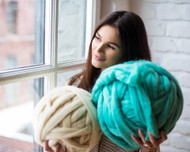5 Facts About Merino Wool
Posted by Like Cloud Designs on 24th May 2018
Hi everyone!
Do you want to know what produces the crimped, fine, and lightweight fleece that becomes the clothing, or the yarn, that you buy from your favourite store?
Well, let me give you some insight. We are not going to look into the wool specs too deeply, so you won't get bored.
The History
The merino sheep can be traced to 12th century Spain. Where, the worth of its soft fleece was recognized. These special qualities of the fleece led the Spanish to ban the export of the merino sheep to monopolies the fleece, and its production. However, something as good as the merino sheep couldn’t be contained and eventually made it to France, then Italy, and from there the rest of Europe. Today, they can also be found in Australia, New Zealand, Russia, South Africa, the United States, and Germany.
The merino sheep are nomadic, live well in semi-arid climates, and through selective breeding have become the foundation of many successful strains of sheep. This selective breeding has created finer, softer, and lighter fleeces.
Merino wool in fashion
For centuries, humans have been using wool to create clothing, but for a long time, it did not have the best of reputations, being too rough and itchy. With its highly resilient properties, it was a favored material for work wear and military uniforms. However, after the World War I, Coco Chanel brought wool onto the runway with a woollen dress. Later, after the World War 2, the House of Christian Dior released a collection, ‘the new look’, that encompassed wool to the extreme. These days, merino wool is so versatile it can be made into almost any kind of clothing, including suits and dresses. It is also used in a cotton blend to create a softer, warmer denim.
Yarns
The merino wool has two classifications: Broad, which has a 19-24.5 micron diameter, or the Ultra-fine, with a diameter of 11.5-15 microns. The ultra-fine wool is blended with other fine materials, such as silk and cashmere. Australia & New Zealand are actually leading exporters of super fine merino wool which is used for production of premium apparel. Skeins of yarn can be bought in different sizes, from a fine ply to a chunky ply.
Chunky (Giant) merino wool yarn become very popular over last years. It's so popular because it offers greater stitch definition and knitting projects are completed quicker. It's a vast field for your imagination and you don't really need to be professional to do something by yourself. Plus it looks so cozy and add warmth to any space in your home.
Merino wool is one of the most versatile and fine natural fibres. It is renewable and bio-degradable, with similar properties to human hair. Merino yarn decomposes within a few years and releases vital nitrogen-based nutrients, unlike synthetic fibres.
Benefits
There are many benefits of merino wool, such as:
Care
The care of wool clothing is a simple as using a wool shampoo/cleaner and putting clothing into the washing machine. Some items require more gentle care though. You can find more about Chunky wool care here.
After all, in the natural world, the sheep are exposed to the weather, rain or shine, so the wool is very durable.
Next time you see a suit, jumper, dress, or blanket ask yourself where fashion would be without the merino sheep :)

